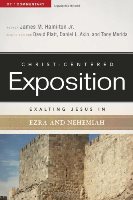Ezra and Nehemiah are some of the best known neglected books in the Bible. We know they are there, and we have all heard of them. But it’s not likely that you’ve heard a series of sermons from them. To be fair, preachers are not always sure how to preach Old Testament as Christian Scriptures, and preaching through narratives is not the easiest preaching to do in the first place. And honestly, a good example from a faithful, well-informed preacher would really help.
This is what Jim Hamilton provides for us in his new Exalting Jesus in Ezra and Nehemiah. Part of the Christ-Centered Exposition series from B&H the focus here is not on interpretation alone but on preaching. And more specifically, the focus is on preaching the Old Testament as a Christian – Ezra and Nehemiah understood and applied in their own setting and in light of the Bible’s big picture. As Preaching Pastor at Kenwood Baptist Church in Louisville, KY, Professor of Biblical Theology at the Southern Baptist Theological Seminary, and Book Review Editor for Biblical Theology here at Books at a Glance, Dr. Hamilton is well qualified for the task. Today he talks to us about his new book.
Books At a Glance:
Many Christians are not terribly familiar with the books of Ezra and Nehemiah, so let’s begin with some basics and the larger picture. Give us a summary of the historical setting of these books. What are they books about?
Hamilton:
Let’s start with a broad-brush OT Timeline.
2,000 BC – Abraham
1,500 BC – Moses
1,000 BC – David
721 BC – Northern Kingdom of Israel Destroyed by Assyria
586 BC – Southern Kingdom of Judah Exiled to Babylon, Temple Destroyed
539 BC – Persia Conquers Babylon, Jews Allowed to Return to Judea
516 BC – Temple Rebuilt (second Temple)
479 BC – Esther Made Queen of Persia
458 BC – Ezra Returns to Jerusalem
445 BC – Nehemiah Returns to Jerusalem
The book of Ezra falls into two parts, Ezra 1–6, and Ezra 7–10. The first part deals with the events of a nearly 100 year period, from 539 BC to 445. The second part covers only one year, that of Ezra’s return, 458–57 (cf. 7:9; 10:17). In the first part, Ezra 1–6, Ezra overviews the return to the land, the rebuilding of altar and temple, and the opposition from outsiders. In the second part, Ezra 7–10, Ezra recounts his own return to the land and the rebuilding of the people, with the opposition from within the community manifest in the intermarriage with idolaters.
The book of Nehemiah treats that good man’s prayerful return to the land to rebuild the wall and rebuild the people, and still the community faces opposition from without and intermarriage with idolaters within. The book opens in 445 BC, and the last date mentioned is 433 BC.
These two books show us how Ezra and Nehemiah teamed up to rebuild the people and the wall.
Books At a Glance:
Who were Ezra and Nehemiah, and what positions did they hold? What were their roles in these events?
Hamilton:
From the world’s perspective, Ezra and Nehemiah were both Persian officials of Jewish descent. Ezra 7 details the diplomatic tasks the Persian king gave Ezra to do when he got back to Jerusalem. Nehemiah was cupbearer for the Persian king, a trusted palace official, allowed by the king to return to Jerusalem to rebuild the city of his fathers’ graves.
From a biblical perspective, Ezra and Nehemiah were seed of the woman, members of the remnant of the peopleof God, exiles seeking the city that is to come. Ezra was a priest who could trace his descent back to Aaron through the line of Phineas, and he was a ready scribe. Nehemiah was also a man of the book, whose prayers are saturated with biblical language.
Both wept over Jerusalem. Both sought to cleanse the people, and Nehemiah cleansed the temple. They were men of integrity, devoted to the word of God, righteous sufferers, whom the Lord used to convict his people of sin and bring renewal of their devotion to himself.
Books At a Glance:
What is the significance of these books in the biblical canon? What is their role in the Bible’s redemptive story?
Hamilton:
I hold to the Tri-Partite order of the books of the OT (Law, Prophets, and Writings). Considered from that perspective, there is a long narrative that runs from Creation to Exile, beginning in Genesis and ending in Kings (Law, Former Prophets). Then comes the poetic commentary on the narrative in Isaiah, Jeremiah, Ezekiel, the Twelve Minor Prophets, and the first part of the writings (Isaiah through Ecclesiastes). After the poetic commentary on the narrative, in the last section of the Writings picks up and continues the thread of the historical narrative, looking forward to the fulfillment of God’s promises (Daniel, Ezra–Nehemiah, Esther, Chronicles).
Books At a Glance:
What divine promises are fulfilled in the events of these books?
Hamilton:
I’m going to leave the details in the book, simply noting here that Ezra and Nehemiah both claim that promises from earlier Scripture are being fulfilled. Ezra mentions Jeremiah in his opening verses, and Nehemiah quotes Daniel’s prayer from Daniel 9. Both books, however, show that the promises are not being consummated, as both books show the people of Israel intermarrying with idolaters.If the promises were being consummated, the people’s hearts would be fundamentally changed and they would not intermarry with unbelievers.
So the promises are being inaugurated but not consummated. Thus we already have inaugurated eschatology in the OT, as we see the already-not yet dynamic at work. The prophecies of Jeremiah and Daniel are already being fulfilled, but not yet like they will be when history arrives at God’s intended consummation of all things.
Books At a Glance:
Any parting thoughts?
Hamilton:
There’s a great deal more we could explore in Ezra and Nehemiah, such as the new-exodus and Davidic worship “patterns” reflected in these books, which are significant for helping us understand messianic expectation, which sets us up to preach Christ from these books. Ezra and Nehemiah are much more than a cookie-jar for the church embarking on a building program! There are good lessons about motivating people, seeking to build God’s kingdom, and leadership, all of which entails the pursuit of Christ-likeness, the one who will build his church. He prayed that God would sanctify his people through his word, and that word includes Ezra and Nehemiah. May the Lord use these books to conform us to the image of his Son.


